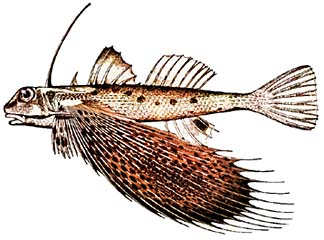Published in the Ocean Watch column, Honolulu Star-Advertiser © Susan Scott
December 11, 2000

Hawaii’s flying gurnard is also called a helmet
gurnard because of its armorlike head bones.
FLYING gurnards. I haven’t heard about or seen one of these unusual fish in years, but lately they’re popping up all over the place.
In the last two months, I’ve received two emails from mainland readers about flying gurnards. One wanted to know if these fish are poisonous (no); the other spotted one while snorkeling in Kahaluu Bay on the Big Island. Then I saw a tiny one, labeled a jet gurnard, in an aquarium store.
Finally, last week, while walking down the sidewalk in the Ala Wai Boat Harbor, I ran into a fellow boat owner. “Want to see an interesting fish?” she asked.
We rushed to the place she saw it, and surprisingly, the fish was still there, strutting like an aquatic peacock. Yep. It was a flying gurnard.
The first thing people ask about flying gurnards is, Can they fly?
People once thought these fish could leap from the water and glide over the ocean’s surface like flying fish. But flying gurnards are heavy bottom fish that can neither leap from the water nor fly over it. Their enormous pectoral fins, however, do look like wings. When the fish spreads these fin-wings fully, they form a near circle around the creature’s narrow body.
Such a display has nothing to do with flight. Rather, it’s a defensive ploy. The extended fins make the fish look bigger and more formidable to potential predators. That’s why, when alarmed, a flying gurnard will display its magnificent wings and walk in circles. If that fails to scare off a predator, this bulky fish will dart away with surprising speed.
When not alarmed, the flying gurnard folds its fins like a fan and tucks them next to its body.
Whether open or closed, the pectoral fins of the gurnard have another function. The leading edge of each fin bears several short spines that are partly free of confining membranes. This allows the spines to move like fingers. If you watch a gurnard carefully, you can see these little fingers scrape and probe the sea floor in search of shellfish, worms, mantis shrimp and fish.
AS if wings with fingers aren’t enough weird features for a fish, this one also has legs. The pelvic fins beneath the flying gurnard’s body also bear short, movable spines that walk the fish forward or backward.
And there’s more. Flying gurnards talk. Well, they make sounds anyway.
The word gurnard (which I spelled wrong in my Nov. 6 column) comes from a French term meaning to grunt. The fish makes grunting sounds, for reasons unknown, by rubbing parts of its jawbones together.
Of the seven species of flying gurnards in the world, Hawaii hosts only one. Look for them, up to 15 inches long, on sandy bottoms in Waikiki waters and around Magic Island. But look hard. These speckled brown, white and sometimes blue fish can blend well with the ocean floor.
If you see one of these rare and beautiful creatures, try sharing the find, like my neighbor did for me. You’ll likely make someone’s day.